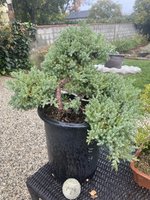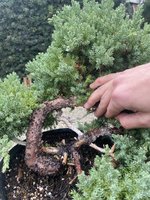Scriv
Yamadori
Hey guys,
My wife bought me this Garden Juniper as a Christmas gift and I was hoping for some feedback on what directions I might be able to take this in.
As you'll see in the photos, the tree already went through an initial styling years ago at the place she bought it from, and there are essentially two trunks emanating from what currently looks like a big knot at the base. The vertical trunk was clearly wired at one point, while the other was allowed to just creep horizontally unimpeded -- or so it seems. The second trunk is coming out of the base at an almost 90 degree angle (180 degrees from the main trunk) and is currently functioning as more of a branch as there is very little foliage on the right side of the tree. Right now it stands about 12 inches tall and the diameter of the vertical trunk is roughly 1.5 inches near the base with a modest taper as it continues upward.
I've been trying to find a comparable looking tree to draw inspiration from, but I honestly haven't seen any other Procumbens Nana with a similar structure.
Any ideas or guidance on how to approach an initial styling this tree would be greatly appreciated.
Thanks!
My wife bought me this Garden Juniper as a Christmas gift and I was hoping for some feedback on what directions I might be able to take this in.
As you'll see in the photos, the tree already went through an initial styling years ago at the place she bought it from, and there are essentially two trunks emanating from what currently looks like a big knot at the base. The vertical trunk was clearly wired at one point, while the other was allowed to just creep horizontally unimpeded -- or so it seems. The second trunk is coming out of the base at an almost 90 degree angle (180 degrees from the main trunk) and is currently functioning as more of a branch as there is very little foliage on the right side of the tree. Right now it stands about 12 inches tall and the diameter of the vertical trunk is roughly 1.5 inches near the base with a modest taper as it continues upward.
I've been trying to find a comparable looking tree to draw inspiration from, but I honestly haven't seen any other Procumbens Nana with a similar structure.
Any ideas or guidance on how to approach an initial styling this tree would be greatly appreciated.
Thanks!
Attachments
Last edited:






